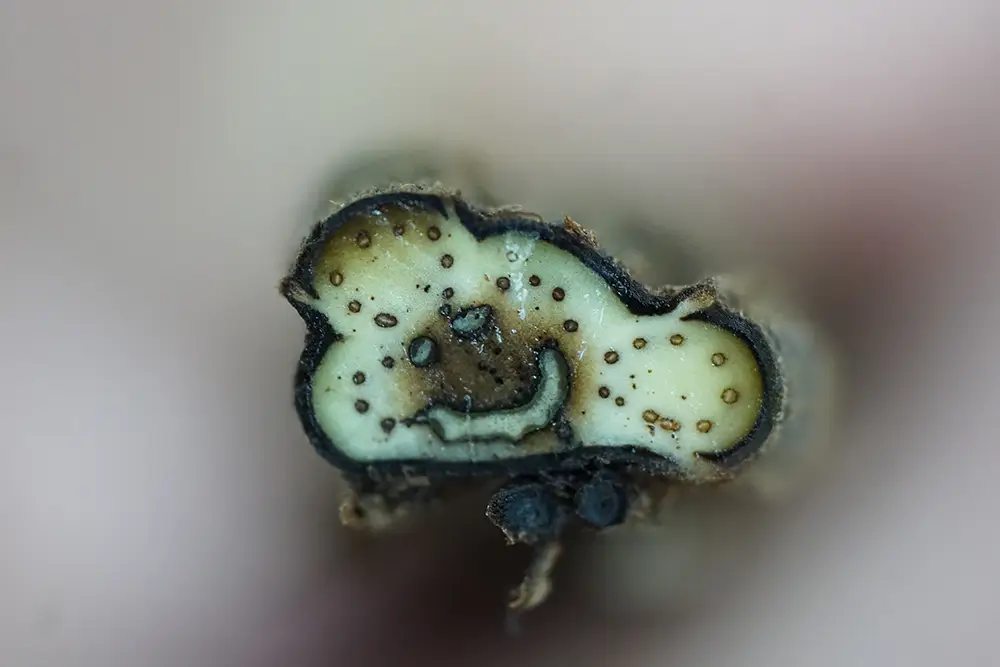Fern Scientist Uncovers How Limits Fuel Evolution

Combining curiosity about ferns with the high-tech imaging available at UT, Professor Jacob S. Suissa is adding new insight into evolution.
Research by Assistant Professor Jacob S. Suissa at the University of Tennessee, Knoxville, is revealing complexity in how ferns have evolved.
Instead of the vascular structure inside fern stems changing as a direct adaptation to the environment, he discovered that shifts in vascular bundle arrangement in the stem are developmentally covaried with leaf placement on the stem.
“As leaf number increases, we see a direct 1:1 increase in vascular bundle number, and as the placement of leaves along the stem changes, we also see a shift in the arrangement of vascular bundles in the stem,” said Suissa, a member of UT’s Department of Ecology and Evolutionary Biology.
For 150 years researchers have focused on how vascular bundles adapt to the environment. Suissa’s new research, published in Current Biology, suggests leaves are steering the evolution of vascular patterns inside the stem.
Cutting-edge Research
Suissa, who has written a book on the evolution of ferns, has been fascinated by plant vasculature for nearly a decade.
In January 2025 he returned to Costa Rica to teach a Tropical Fern Biodiversity course he took as a graduate student. As part of this course, Suissa led a research project on a fern called Mickelia nicotianifolia, commonly known as tobacco fern, which has a long creeping stem that climbs up trees. While his students collected data on the tobacco fern, Suissa was cutting up the fern with a simple razor blade.

“I noticed that the leaves of this fern are always produced on the dorsal or upper side of the fern stem and the vascular patterning in the stem looks quite whimsical, like a smiley face, with an elongated ventral bundle and several separated bundles at the top that were seemingly associated with the placement of leaves,” Suissa said.
He set out to determine if the arrangement of leaves around the stem was correlated with the number and arrangement of vascular bundles within the stem.
Back in Knoxville, Suissa sampled 27 genera of ferns, which represented 30% of all fern species diversity, and using a newly acquired microCT (essentially a large CAT scanner) housed in UT’s Advanced Microscopy and Imaging Center, he analyze the internal anatomy of fern stems without having to cut into them.
Suissa found a striking correlation between the number of leaf ranks along the stem and the number of vascular bundles within the stem. This relationship was almost one to one in some instances—for instance, five ranks of leaves, five bundles in the stem. What’s more, the arrangement of leaves determined the spatial arrangement of bundles. If the leaves were arranged spirally, the vascular bundles were also arranged in a radial pattern. If the leaves were shifted to the dorsal side of the stem, the smiley face pattern emerged. So, the smiley face arrangement of the tobacco fern vasculature was due to the placement of leaves exclusively on the upper side of the stem.
This may not sound all that surprising, but it is counter to how the fern vascular system has been viewed for over 150 years. Most studies on fern vascular patterning have tried to pick out the arrangement of vascular bundles and explain how they evolved individually under direct natural selection. However, Suissa’s new study suggests that the arrangement of vascular bundles in the stem is not an individual trait that can evolve independently. Rather, the vasculature in the stem is inexorably linked to, and explicitly determined by, the number and placement of leaves along the stem.
“Often, we think of research as requiring high-tech instrumentation, and intensive manipulative experiments in the lab, but natural history observations can yield quite impactful insights. This work has a bit of both,” Suissa said. “It started as a simple observation in the field, and most of the work was done with a razor blade and a camera, but I was also able to integrate high-tech equipment like the microCT and quantitative evolutionary tools for projecting traits into the past to understand how they evolved.”
Exploring Evolutionary Data
Suissa’s now working with his lab to examine how fern vasculature has evolved across their almost 400-million-year history.
“I am working on a massive dataset exploring the evolution of fern vascular architecture, including over 300 species spanning every single fern family,” he said. “Our hope with this project is to understand how different scales of construction in the vascular system—from cellular to architectural—can evolve, and have evolved across the ferns.”
By Amy Beth Miller